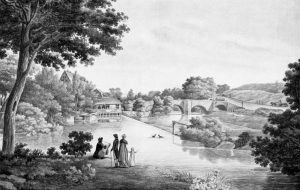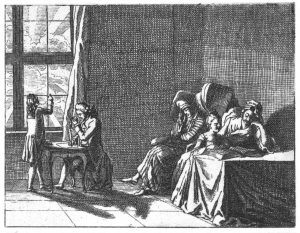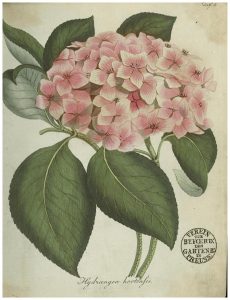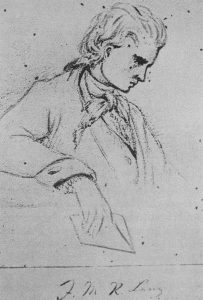A scholar of the Long Enlightenment, my work revolves around the emergence of the middle class as the dominant cultural force in Germany. I explore how discourses such as literature, philosophy, pedagogy, visual and material culture and new social formations such as the changing love paradigm, the invention of childhood, and the professionalization of the emergent bourgeoisie and the attendant cultural practices contributed to the political restructuring of society.
- Work in Progress: Domesticity
- Lifestyle
- Fashion
- Gardens and Design
- J.M.R.Lenz
- Gender
- Elise Bürger
- Early Modern Culture
Work in Progress
Working Title: The Feel of Home: Imaginaries of Domesticity and Women’s Work in Late 18th Century Germany
My current work analyzes the intense discourse on the creation of the domestic sphere as a multidimensional site in which Enlightenment principles were put into practice. Domesticity, the highly desirable “feel” or ambiance of the middle class lifestyle, characterized the pleasant and nurturing domestic environment. As a set of practices, feelings, and values culminating in a particular emotional and physical ambiance—a sense of being at home and belonging—, it is domesticity that connects the material environment and the subjective experience.
—Weimar and Beyond: Visual Culture and Bertuch’s Journal des Luxus und der Moden, American Society for Eighteenth-Century Studies, Minneapolis, 2017
—“The Creation of Lifestyle as a Formation of Popular Culture in the Journal des Luxus und der Moden.” American Society for Eighteenth-Century Studies (ASECS). Los Angeles. March 2015.
—“The Journal des Luxus und der Moden as Significant Medium in the Refashioning of Domesticity Around 1800.” American Society for Eighteenth-Century Studies (ASECS). Williamsburg. March 2014.
—“Family: Domesticity and Culture Around 1800.”German Studies Association. Denver. October 2013.
—Organized: “Creating and Cultivating Domesticity I.” Modern Language Association. Seattle. January 2012.
—Organized: “Creating and Cultivating Domesticity II.” Modern Language Association. Seattle. January 2012.
Eighteenth-Century Lifestyle
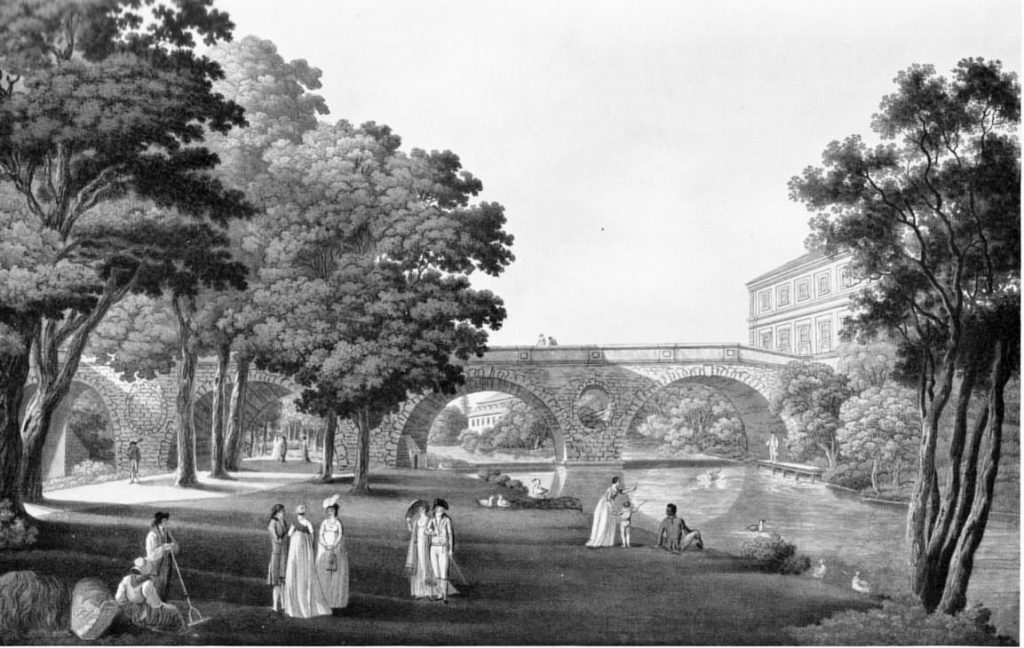
Cultural and aesthetic change has important material dimensions. My work in textual and visual representation of artifacts and cultural practices adds nuance to the narrative of social and cultural transformation in late Enlightenment Germany.
—Fabricating Pleasure: Fashion, Entertainment, and Cultural Consumption in Germany, 1780-1830. Detroit: Wayne State University Press, 2005.
—“Was ‘Geist und Sinne lebhaft beschäftigt’. Einige Überlegungen zum Unterhaltungsbegriff im ‘Journal des Luxus und der Moden’.” Das Journal des Luxus und der Moden: Kultur um 1800. Eds. Manger, Klaus and Ralf Dressel. Heidelberg: Winter, 2004. 105-21.
—“The Creation of Lifestyle as a Formation of Popular Culture in the Journal des Luxus und der Moden.” American Society for Eighteenth-Century Studies (ASECS). Los Angeles. March 2015.
—“Historicizing Pop: The Case for Historical Cultural Studies.” Keynote Address. Graduate Student Symposium on Popular Culture. University of Minnesota. Minneapolis. March 2001.
—Invited Lecture: “Einige Überlegungen zum Unterhaltungsbegriff im Journal des Luxus und der Moden.” Symposium: Das Journal des Luxus und der Moden: Kultur um 1800. Sonderforschungsbereich Ereignis Weimar-Jena – Kultur um 1800. Jena, Germany. June 8-9. 2000.
—“The Valorization of Novelty in Eighteenth- Century Culture.” German Studies Association. Atlanta. October 1999.
–“The Creation of Desire and Longing and the Emergence of Cultural Consumerism in Late-Eighteenth Century Germany.” American Association of Association of Eighteenth Century Studies. Milwaukee. March 1999.
Fashion
My work on fashion and the body ranges from its representation in the fashion journal as a significant part of the emerging lifestyle of the various layers of the middle class, the work that dress as national costume performs in the creation of nationalistic fervor, to the body representing neoclassicist artifacts (Attitüden).
—Fabricating Pleasure: Fashion, Entertainment, and Cultural Consumption in Germany, 1780-1830. Detroit: Wayne State University Press, 2005.
—“Fashioning a Nation: Fashion and National Costume in Bertuch’s ‘Journal des Luxus und der Moden’ (1786-1827).” German Studies Review 28.2 (2005): 367-86.
—“Designing the Self: Fashion and the Body.” Body Dialectics in the Age of Goethe. Eds. Pausch, Holger and Marianne Henn. Amsterdamer Beiträge. Amsterdam: Rodopi, 2003. 47-66.
—“The Self-Fashioning of the Bourgeoisie in Late-Eighteenth-Century German Culture: Bertuch’s ‘Journal des Luxus und der Moden’.” Germanic Review 72.3 (1997): 170-82.
—The Construction of Gender in Early Fashion Journals.” American Association of Teachers of German (and ACTFL). Chicago. November 2004.
—“The Role of the Periodical in the Construction of the Material Culture of Fashion.” American Society for Eighteenth-Century Studies. Boston. March 2004.
—Invited Lecture: “Fashion and Bourgeois Identity Construction in Bertuch’s Journal des Luxus und der Mode.” University of Maryland. Maryland. February 2001.
—“Fashion and the Nation in Bertuch’s Journal des Luxus und der Moden.” American Association of Association of Eighteenth Century Studies. Philadelphia. April 2000.
Gardens and Design
The garden-mania of the 18th century is legend ranging from reshaping gardens in an adaptation of the English landscape garden to the horticultural experiments in one’s own garden. As the well-to do spent summers in their garden, distinct lifestyles with their own leisure practices emerged away from the duties of the day-to-day.
—“Topographie der Geselligkeit: Geselligkeit und Gartenkultur um 1800.” Geselliges Vergnügen. Kulturelle Praktiken von Unterhaltung im langen 19. Jahrhundert. Eds. Ananieva, Anna, Dorothea Böck and Hedwig Pompe. Bielefeld: Aisthesis, 2011. 11-25.
—“The Shaping of Garden Culture in the Journal des Luxus und der Moden (1786-1827). Publishing Culture and the Reading Nation.” German Book History in the Long Nineteenth Century. Ed. Tatlock, Lynne. Columbia, S.C.: Camden House, 2010. 40-80.
J.M.R. Lenz
Fascinated by J.M.R. Lenz’s unconventional narratives, my work utilizing narrative theory to delineate the innovations that he used to destabilize traditional plot structures, temporal arrangements, and characterizations in order to interrogate the emergent models for the self-formation of the rising middle class.
—Das Schlaraffenland verwilderter Ideen”: Narrative Strategien in den Prosaerzählungen von J. M. R. Lenz [“Wild Ideas in the Land of Plenty”: Narrative Strategies in J.M.R. Lenz’s Prose Works]. Würzburg: Königshausen & Neumann, 2014.
—Wurst, Karin A. and Alan Leidner. Unpopular Virtues: J. M. R. Lenz and the Critics. A Reception History Columbia, S.C.: Camden House, 1999.
—Edited and introduced J.R.M. Lenz als Alternative? Positionsanalysen zum 200. Todestag 1791. Köln, Wien, Weimar: Böhlau, 1992.
—J.M.R. Lenz, ‘Prosa’.” Handbuch Jakob Michael Reinhold Lenz. Leben – Werk – Wirkung [Handbook: Jakob Michael Reinhold Lenz. Life – Works – Reception]. Eds. Freytag, Julia, Inge Stephan and Hans-Gerd Winter. Basel: DeGruyter, 2017.
—“Narrative Strategien im Erzählwerk von J.M.R. Lenz.” Text und Kritik (2000): 36-43.
—“ ‘Der gekreuzigte Prometheus’. J.M.R. Lenz: Wirkungsgeschichte in Literaturwissenschaft und -Kritik.” ‘Ich aber werde dunkel sein’. Ein Buch zur Ausstellung J.M.R. Lenz. Ed. Kauffmann, Ulrich. Jena: Bussert, 1996. 109-16.
—“Contradictory Concepts? The Artist as Reformer. J.M.R. Lenz’s ‘Der Landprediger’.” Order From Confusion. Essays Presented to Edward McInnes. Ed. Deighton, Alan. New German Studies Hull: University of Hull Press, 1995. 28-53.
—“Über die Unmöglichkeit der Quadratur des Zirkels: Erzählstrategien in J.M.R. Lenz’ ‘Zerbin’.” Lenz-Jahrbuch 3 (1993): 64-86.
—“A Shattered Mirror: The Concept of Mimesis in J.M.R. Lenz’s Theoretical Texts.” Space to Act J.M.R. Lenz. Eds. Leidner, Alan and Helga Madland. Columbia, S.C.: Camden House, 1993. 106-20.
—“J.M.R. Lenz’ Poetik der Bedingungsverhältnisse: ‘Werther’, Die ‘Werther Briefe’ und ‘Der Waldbruder ein Pendant zu Werthers Leiden’.” J. M. R. Lenz. Positionsanalysen zum 200. Todestag 1791. Ed. Köln, Wien, Weimar: Böhlau, 1992. 198-219.
—“Überlegungen zur ästhetischen Struktur von J.M.R. Lenz’ ‘Der Waldbruder ein Pendant zu Werthers Leiden’.” Neophilologus. An international journal of modern and medieval language and literature 74.1 (1990): 70-86.
Gender
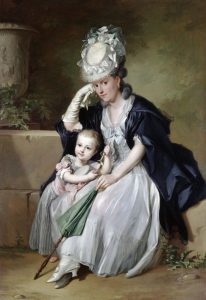 My early work focused on the psycho-social power structures within the new form of the family as it was discursively constructed in the Enlightenment. Another strand in my research interrogates how gender influenced the aesthetics of women writers, in particular, dramatists. My more recent work focuses on the forms of empowerment that women imagined, constructed, and visualized in their texts.
My early work focused on the psycho-social power structures within the new form of the family as it was discursively constructed in the Enlightenment. Another strand in my research interrogates how gender influenced the aesthetics of women writers, in particular, dramatists. My more recent work focuses on the forms of empowerment that women imagined, constructed, and visualized in their texts.
—Edited and introduced Frau und Drama im achtzehnten Jahrhundert [Women and Drama around 1800]. Köln, Wien, Weimar: Böhlau, 1991.
—Edited and introduced: Eleonore Thon’s ‘Adelheit von Rastenberg’. Text and Translation Series. New York: Modern Language Association, 1996.
—Introduced Eleonore Thon’s ‘Adelheit von Rastenberg’. English translation by George Peters. Companion Volume: Text and Translation Series. New York: Modern Language Association, 1996.
— “Gender and Identity.” Companion to the Works of Lessing. Eds. Fox, Thomas C. and Barbara Fischer. Rochester 2005. 231-57.
—“ ‘Wilde Wünsche’: The Discourse of Love in Storm and Stress Literature.” Storm and Stress. Ed. Hill, David. Rochester: Camden, 2003. 217-40.
—“The Hazards of Marriage as Love Match: Women Dramatists in the Late Eighteenth Century.” Seminar 38.4 (2002): 313-31.
—“Spellbinding: The Body as Art / Art as Body in ‘Attitüden’.” Lessing Yearbook 32 (2001): 151-81
—“ ‘Begreifst Du aber / wie viel andächtig schwärmen leichter, als / Gut handeln ist?’ Elisabeth (Elisa) Charlotte Konstantia von der Recke (1754-1833).” Lessing Yearbook 25 (1993): 97-116.
—“Nicht-Anwesendsein-Schweigen-Tötung. Die Möglichkeiten der Frau? Lessings Funktionalisierung literarischer Motive.” Orbis Litterarum 45 (1990): 113-27.
—“Creativity: Women, sociability, and Cultural Networks”. Conference talk. German Studies Association, San Diego, 2016.
Elise Bürger
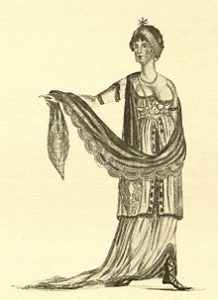 Elise Bürger was caught in the tension between having to make a living from her literary works and her ambition to create more than popular fare. Her oeuvre, which spans all genres and includes fascinating glimpses at popular cultural phenomena like Attitüden and Living Pictures, allows important insights into the contested divide between High Culture and Popular Culture.
Elise Bürger was caught in the tension between having to make a living from her literary works and her ambition to create more than popular fare. Her oeuvre, which spans all genres and includes fascinating glimpses at popular cultural phenomena like Attitüden and Living Pictures, allows important insights into the contested divide between High Culture and Popular Culture.
—“Elise Bürger (1769-1833) and the Gothic Imagination.” Women in German Yearbook 13 (1997): 11-27.
—“Spurensicherung: Elise Bürgers Einakter ‘Die antike Statue aus Florenz’ (1814) als Beispiel dramatischer Experimente an der Jahrhundertwende.” Goethe Yearbook 8.1 (1996): 210-37.
—“Negotiations of Containment: The ‘Trivial’ Tradition and Elise Bürger’s ‘Adelheit, Gräfinn von Teck’ (1799).” Thalia’s Daughters. German Women Dramatists from the Eighteenth Century to the Present. Eds. Cocalis, Susan L. and Rose Ferrel. Tübingen: Franke, 1996. 35-51.
Early Modern Culture
The Early Modern Period offers interesting insights how epistemological change happened. As the knowledge networks within Europe, such as the various collections and the Cabinets of Curiosities, expanded and were transformed into more specialized scientific collections, they destabilized the Renaissance paradigm, by providing the material underpinnings for modern science.
—“The Utility of Play and the Enchantment of Instruction and Social Encounters: Georg Philipp Harsdörffer’s ‘Frauenzimmer Gesprächspiele’.” Foreign Encounters in Early Modern Culture. Eds. Ehrstine, Glen and Mara Wade. Special edition to Daphnis 2005. 285-302.
—“Gender and the Aesthetics of Display: Baroque Poetics and Sartorial Law.” Daphnis Zeitschrift für mittlere deutsche Literatur 29.1-2 (2000): 159-75.
—“Die Frau als Leserin und Mitspielerin in Harsdörffers ‘Frauenzimmergesprechspielen’.” Daphnis Zeitschrift für mittlere deutsche Literatur 21.4 (1992): 615-39.
—“Curiosity and Collecting in the Early Modern Period.” Modern Language Association Meeting, Austin, 2016.
—“Peregrinations and the Grand Tour.” Renaissance Society of America Conference. Berlin. March 2015.
—“Curiosity. Memory. and the Raritätenkammer: The Grand Tour and Collecting in Early Modern Germany.” Modern Language Association. Los Angeles. January 2011.
—“Teaching the Grand Tour.” Modern Language Association. Chicago. December 2009
—“Text into Image. Image into Text in Harsdörffer’s Frauenzimmer-Gesprechspiele.” Modern Language Association. Philadelphia. December 2006.
— “Seeing Stories of Sociability in Georg Philipp Harsdörffer’s Frauenzimmergesprechspiele.” Modern Language Association. Philadelphia. December 2004.
